 |
| terrible photo I stole from the internet. |
I just repaired a Hohner International K1 Electronic Piano. This is a compact (but heavy) electronic piano/harpsichord/bass. Unlike its glamourous distant relatives the Pianet and Clavinet, this latecomer (1974) is not an Electric Piano. I'm not trying to be difficult, but the differences are significant. Traditionally, an electric piano produces sound acoustically (physically vibrating bits) and electrically boosts it with built in pick-ups and preamp while an electronic piano creates sound using only electronic components. An electronic piano is more like a combo organ with special attack and decay characteristics than a piano.
 |
| from clavinet.com |
In the Hohner Pianet sticky pads lift up, twanging a metal tine. A Fender Rhodes hits metal reeds with hammers, as does a Wurlitzer (which calls itself an electronic piano but isn't). These reeds are sized or weighted to produce a specific pitch, one for each key. A Hohner Clavinet is more like a harp laid flat, with two big pickups across all the strings. When you hit the key a rubber-tipped bit 'hammers-on' the string. It works like 10 sideways guitars with tone control and a crappy amp built in.
Anyway, they all produce sound physically, pick it up in a manner similar to how guitar pick-ups operate (vibrating metal near a coil) and boost it up and send it out the back. Not very much electric bits inside really. And the sound is varied and slightly out of tune and full of wonderfully lush and queasy harmonics and beat frequencies and overtones and dynamics etc..
The qualities of these instruments are well known and much discussed. Now we can discuss the K1 (or H1) ELECTRONIC piano.
An Electronic Piano has no mechanical resonators. The keys activate switches which instead control electronic oscillators and filters designed to imitate the tone of a real piano or harpsichord. These instruments get a lot of fairly just criticism when compared to what they are supposed to be imitating. They (esp. these budget keyboards from the mid to late seventies) lack touch response and sonic depth, always sounding kind of smothered and wimpy. WELL SO WHAT! You don't always need a big fat sound, sometimes you want a little distance and shyness.
This is CLUSTER in 1976 using electronic pianos unabashedly...
Compared to an electric piano these also offer more sonic options in less space (and I'm sure this helped sell them originally). The K1 has two tonally different 'piano' settings, a great brash 'harpsichord' and a two octave bass that can be selected or not, as well as faders for mixing any of these timbres together. This allows for a fairly satisfying tone somewhere in the mix. You also get vibrato, in this case a wide and wobbly one with depth and speed control. The sound is often described as cheap, and you can get these electronic pianos for cheap as well. But I love them! It all depends on what you do with it! I have a Wurlitzer and a Pianet and had a Rhodes but I always have an electronic piano around as well.
But this is supposed to be a record of repairs, not a defense of mid-range equipment! I always have a soft spot for the underdog, though, so when PAUL'S BOUTIQUE was on the brink of tossing this HOHNER K1 I was happy to take a look-see. There is an intimidating battery of components inside these electronic pianos - worse than combo organs - but it isn't as bad as it looks!
